|
As I was perusing
the coral tanks in a fish store a year or so ago, I recall
overhearing a conversation between a staff member of the store
and a budding reef hobbyist. A large display aquarium sat
just around the corner replete with many stony corals, mostly
of the genus Acropora.
"This," the staffer explained, "replicates
a high energy reef zone. The lighting is strong, the water
flow is strong and the corals are fast-growing." Well
enough said, I thought to myself. "These are mostly small-polyped-that
is, small-mouthed-corals." I suppose that's true, I thought.
Those corals do all have fairly small polyps. "These
corals, on the other hand," pointing to a tank containing
colonies of the genus Euphyllia and then motioning
to some mussids and a few Trachyphyllia, "are
large-polyped-that is, large-mouthed-corals. With such a large
mouth they tend to have a large demand for food and a smaller
demand for light, whereas the small-mouthed corals tend to
have a bigger demand for light and less demand for food."
The hobbyist nodded excitedly as she was introduced to a new
world of knowledge. I couldn't help but sigh to myself.
Having spoken with hobbyists from across the country and
at many experience levels, it is my distinct impression that
most people have no idea how dissimilar different species
of coral are, and that they differ in some very important
ways. This is very understandable, though. Most corals cannot
be identified to the species level simply by looking at them.
The conundrum we face as aquarists is that a large and diverse
group of animals have numerous species that look more-or-less
similar yet the needs of these animals, their tolerances and
countless other variables important to their care are often
very different. Understanding what differentiates the various
species can be critical to their success in captivity. It
is fortuitous for hobbyists, then, that most corals are very
adaptable. Even if the perfect set of conditions is not achieved
(as if anyone has any idea what is "perfect" for
even a single coral species, much less all species), most
corals will grow and live just fine. An ideal environment
is rarely, if ever, available in nature, after all. Because
of these tolerances, people were able to discover acceptable
methods of maintaining certain corals over the years. Then,
when similar looking species were imported, the same recipe
for success was applied to them. Very quickly, the methodologies
that proved successful for some species became "the way"
to keep all species that had a "similar" physical
appearance. After several years reefkeepers solidified a particular
method of husbandry for each recognized group: small-polyped
stony, large-polyped stony, and soft corals, zoanthids, and
mushroom polyps. The problem with applying this cookbook style
of reefkeeping is that it utterly ignores the true diversity
that exists within or between each group. This is analogous
to saying that seals, bears and wolves are really all the
same animals and have the same needs. Obviously, this is not
the case, yet a similar argument is propagated in reefkeeping
circles simply by utilizing these terms and believing that
they confer some knowledge about a certain coral's requirements.
Simply put, the idea that these terms give us any useful
information about light, water flow, food or any other requirements
is a myth, and I wish to debunk it.
 |
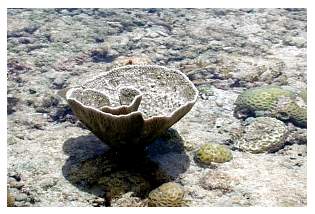 |
|
Stony corals can be found in very shallow water or intertidally
regardless of the size of their polyps.
Photos courtesy of Eric Borneman.
|
The Myth
The biggest risk
of simplifying is always oversimplifying. It
is important to communicate without tossing in every detail
and minutiae because, usually, too much is known about anything
to say everything at once. Communication should be detailed
enough to get the point across, and not much more. In trying
to relay a great deal of information or necessarily complicated
information, it is possible to leave out important details-details
that make a big difference-merely in an attempt to make the
message understandable. If someone said to a reefkeeper, "Tell
me everything you know about having a reef tank in ten minutes,"
he or she would struggle to generate anything coherent at
all. Probably what most people would do is start with very
basic ideas: aquarium, live rock, saltwater, pumps, lights,
skimmers, etc. Certainly, given time, most anyone could describe
how to set up a new tank, or more-or-less how to replicate
his or her own. Without a doubt, however, many
finer points that wouldn't be mentioned in this first meeting
are required knowledge when keeping a tank. For example, someone
might forget to mention to use freshwater and not saltwater
for evaporative top-off. Most new hobbyists would never think
to use anything but saltwater for top-off in their saltwater
tank, and as is obvious to an experienced hobbyist, up would
go their salinity. Weeks or months later, as the salinity
has risen near 50 psu and everything in the tank is dead or
dying, the new hobbyist will wonder why and have no idea what
to do. Of course, all that was needed was freshwater top-off,
or rather the information that freshwater top-off is
required. This is a minor detail, and something most people
wouldn't think to mention and most new hobbyists wouldn't
think to ask about, but nonetheless it is critical to the
tank's success. I would suggest that using terms such as SPS,
LPS or any other such shorthand is very much like saying,
"Use saltwater in your saltwater tank," with no
other information. It is a gross oversimplification of very
large and complex groups, and to base decisions about care,
hardiness, aggression or any aspect of husbandry at all on
these designations can, and will, lead to problems and mortality,
not to mention thousands of wasted dollars and heartache on
the part of the aquarist. As I will explain in the following
sections, it simply is not good enough to say something is
an SPS coral and therefore should receive the care that other
SPS corals need, or that something is a softy and is therefore
tolerant of some set of conditions like other soft corals.
First, let me review each of the five recipes-the five myths-before
I go about re-evaluating them. This isn't likely new information
for anyone. Indeed, this is what people already know, or rather,
what they think they know. Through my experiences and
contact with other aquarists, I believe these five characterizations
are representative sentiments of the majority of hobbyists
with regard to each group.
-
Mushroom Polyps (order Corallimorpharia): They like dirty
water with high nutrient levels. They don't like bright
light or much water flow. They don't need food, just some
light and nutrient-rich water. They're very hardy and
are great inhabitants for a new tank.
-
Zoanthids (order Zoanthidea): They should be called zoos
because they are ZOOanthids. They don't care about dirty
water with high nutrient levels. They don't need much
light or water flow. They don't eat; they just use light.
They're very hardy and ok to put into a new tank.
-
Soft Corals (subclass Octocorallia): They need dirty,
nutrient-rich water. They don't like bright light or strong
water flow. They produce toxins that hurt "SPS."
They don't need food, just light and nutrients in the
water. They're good to put into a new tank, and to later
upgrade to stony corals. They're very hardy.
-
LPS Corals (order Scleractinia): This is an acronym for
large-polyped stony/scleractinians, i.e., stony corals
with relatively larger, fleshier polyps than SPS. They
don't mind nutrient-rich water. They don't like very bright
light or strong water flow. They need to be fed on occasion.
They're hardy and good to mix in a tank with the previous
three groups.
-
SPS Corals (order Scleractinia): This is an acronym for
small-polyped stony/scleractinian corals, i.e., stony
corals with relatively smaller, less fleshy polyps than
LPS. They need very clean, nutrient-poor water. They need
super-bright light and very strong, chaotic water flow.
They don't need any food, just light. They're very sensitive
and difficult to keep. They don't take stress well. When
they're happy, they turn beautiful colors, but only if
the tank is nutrient-poor. If they aren't colorful, nutrients
in the aquarium are making them turn brown.
The Reality
Most people probably have sentiments
in keeping with the bullets above, though I've listed these
ideas as myths. It is said that there is some truth to every
myth, and that is very much the case with what I've stated
above. The problem is, again, an oversimplification that leads
to ideas and methods that are just downright incorrect or
harmful. To illustrate why these ideas don't hold up, I'll
take each section above and point out its half-truths and
incorrect information.
Mushroom Polyps (order Corallimorpharia)
Mushroom polyps, which are termed corallimorpharians, are
often said to "like" or "need" dirty water
in order to do well. Well, let's see why. I've certainly seen
tanks that had very high nitrate readings along with detectable
phosphate that grew mushrooms very well. These tanks usually
have a very small, or no, protein skimmer installed. Some
mushrooms certainly seem able to tolerate high nutrient levels.
I've also seen other tanks with very low levels of nitrate
and phosphate due to the use of a large skimmer and minimal
feedings. Sure enough, the mushrooms didn't grow well at all.
So, case closed, right? Mushrooms + nitrate = good, right?
Well, it's not that simple. Various species of corallimorphs
grow in a variety of environments in nature, but the species
we are all interested in, and the ones that we put into our
reef tanks, come from tropical coral reefs. Most species are
found in somewhat protected parts of the reef, often in turbid
water. Nowhere on a coral reef, however, do the nitrate levels
approach even a twentieth of what is often considered high
or nutrient-rich in captivity. They grow just fine on the
reef even though the dissolved nutrient levels (especially
dissolved inorganic nitrogen, DIN) are extremely low (see
D'Elia and Wiebe, 1990). Hmmm, perhaps it's not that they
need dirty, nutrient-rich water. One thing that is present
on coral reefs in great abundance (Anthony, 1999) that is
usually much scarcer in reef tanks is particulate organic
material (POM). This is the term for feces, algae, bacteria,
mucus and other gunk floating around in the water. Often tanks
with small protein skimmers contain more of this material
(as well as dissolved organic material, DOM-the division between
the two at the lower size ranges is somewhat arbitrary) simply
because the waste produced in the tank is not readily removed,
so it can become suspended. In tanks with big skimmers, most
of this material is quickly removed. Corals seem to actively
use this as a food source, and those living in calm areas
rely on it more heavily (Anthony, 1999; Anthony and Fabricius,
2000; Mills et al., 2004; Mills and Sebens, 2004),
and mushrooms are no exception. Perhaps what they like and
need is not nutrient-rich water but rather food in the form
of suspended or dissolved material. I would suggest that this
is exactly the case. The largest species of corallimorph,
Amplexidiscus fenestrafer, is in fact a piscivore and
may actively lure fish to itself with chemical attractants
(Hamner and Dunn, 1980). Many other species, especially azooxanthellate
corallimorphs, can be very active predators. There are a few
little Pseudocorynactis sp. in one of my tanks that
feast on any particle they can grab whenever I feed the aquarium.
In fact, recent studies confirm that corallimorphs thrive
on portions of a reef with a high availability of particulate
material (due primarily to land-based run-off) and can even
competitively displace stony corals in such situations (Kuguru
et al., 2004; Muhando et al., 2002).
The problem with generalizing about their need for light
is that there are many species in this order and each has
different tolerances and requirements. Many aposymbiotic (lacking
zooxanthellae) corallimorpharians can be found growing in
very dim locations, either in deep water or in shaded locations,
but not always. Other species grow in turbid water, on vertical
walls, in overhangs or in somewhat shaded locations. Still
other species (or other individuals of the previous species)
grow in clearer, shallower water and receive much more light.
Ricordea florida is regularly found in seagrass beds,
often in only a few feet of water, but it also lives in deeper
water and can be found in much dimmer light. On a recent trip
to the Caribbean I found a large Discosoma sanctithomae
(which may be reclassified as Rhodactis sanctithomae
soon) colony growing in about 3 m of water on the north side
of St. John, USVI. The colony was oriented at an angle (which
diminishes the amount of light received by the coral), but
the sun here was still intense and not at all reminiscent
of what is often recommended for these corals. The problem
is that different species and different individuals can, and
do, live in radically dissimilar light levels in nature. Interestingly,
Muhando et al. (2002) found the corallimorphs in their
study to be most common in the shallowest water, especially
on the reef flat and reef crest where conditions (such as
aerial exposure during low tide) may be stressful. We would
all be foolish to think that this large group of organisms
has a single and particular light requirement. The same can
be said for water flow requirements. None of the species we
keep in aquaria seems to prefer truly strong water flow, but
some are obviously more adept at utilizing it than others
are. The Discosoma sanctithomae mentioned above was
found growing not more than a meter away from a large Acropora
palmata (a coral dependent upon strong water flow) and
in a fully exposed position. The wave action here is normally
quite strong, though it was relatively calm the day I visited.
Other species such as the lovely, temperate Corynactis
californica typify areas of strong currents and crashing
waves. Were this and similarly adapted species kept in weak
water flow it could be disastrous for them. Species with many
surface irregularities such as Ricordea spp. and Rhodactis
spp. are often found in areas with significantly faster water
flow than those with smooth surfaces, but not always. This,
too, is a simplification and we cannot say with any degree
of certainty (at least at this point) that a coral came from
a particular location because it has some particular polyp
shape. Realistically, the best that can be done at this point
is to observe the coral in the aquarium and see how it responds
to various flow regimes. Creating rules and recipes to apply
to corals can always falter. Observing how a particular coral
responds to particular stimuli (more or less water flow) cannot.
As for the last point, many corallimorphs are very hardy,
but not in every situation or in every tank, from what I have
seen. Usually these corals seem to thrive in most reef tanks
and reproduce spontaneously. I have seen on many occasions,
however, these same corals languishing, shrinking and eventually
dying in other tanks, especially those that are more than
a year old and that are considered to be very nutrient-poor
(usually meaning small food additions and significant nutrient
removal) by reefkeeper standards. Why they might thrive in
one tank that seems to be in poor condition only to die in
another seemingly healthy tank is the subject of another debate,
but nonetheless they are not the easy, "can't-kill-them,"
"everybody-can-keep-them" corals that they are often
said to be. They, like any organism, can do poorly in captivity,
and especially in new tanks they can have a hard time just
as other corals can. They have certain requirements for health
and vigor. If these are met, they thrive; if not, they don't.
Zoanthids (order Zoanthidea)
Notice that this word contains only a single "o."
A zoo is a place where animals are kept on display, whereas
zo-(rhymes with toe) is a prefix meaning "animal."
Actually, the prefix zo- and the word zoo have completely
different etymologies; that they appear to be similar is just
coincidence. This is a simple point, but I can't overstate
how it grates on the ears of folks who know better. My advice
in any endeavor would be to know the correct pronunciations
of its words; otherwise we seem less-informed than we truly
are.
As mentioned above for corallimorpharians, zoanthids do not
need and are not necessarily healthier in high nutrient water.
Tropical species often grow on the same reefs as our other
corals, and there is no reason to assume that their needs
for dissolved inorganic nutrients should be different than
that of any other groups of corals. They do seem fairly tolerant
of conditions that other corals often don't tolerate, but
this is no reason to push them to their limits. They have
no more place in a new, immature tank than does any other
coral. Similarly, a dog might be able to go two months without
food whereas a cat might only survive one month, but who would
test this on their pets? It probably isn't a good idea to
see how far our charges can stray from suitable conditions
and still survive. Along these lines, nutrient-rich water
does not satisfy all the nutritional needs of most zoanthids.
In fact, many of them are decidedly predatory (Tanner, 2002)
and some absolutely feast on any food offered. Other species
tend to be much pickier in what they will accept. In general,
species in the genus Zoanthus tend to rely heavily
on light, dissolved nutrients and detritus. Some species readily
take certain prey but reject many others. Finding out what
they will and won't take is largely a matter of trial and
error. In nature plenty of whatever they eat is usually available,
so obtaining sufficient food is rarely an issue for wild zoanthids.
Due to the very limited plankton populations in our tanks,
this is not the case in captivity. Species from some of the
other genera tend to take food more readily, especially some
Protopalythoa spp. Some individuals in this genus can
be absolutely ravenous, and while they use light to a large
extent (like most reef corals), food seems to be more important
(Tanner, 2002). The polyps of a particular colony that was
in my care often would catch and engulf five or six pellets
or two or three mysid shrimp at a time. Each polyp would then
reopen within minutes and take the same amount of food again.
I have fed this colony this amount of food four and five times
a day, and it eagerly takes the food each time and expands
again, tentacles waving in the current. So much for zoanthids
not eating.
In terms of light intensity and water flow, luckily, these
corals are very adaptable. They certainly can and do grow
in modest light levels and weak water flow, and this is often
what they're given in captivity. More often in nature they
are actually found in shallow water where light is very strong
and water flow can be turbulent. On a large granite boulder
in "The Baths" on Virgin Gorda, BVI I saw a carpet
of Palythoa sp. covering at least 300 if not 400 ft.2
reaching from the surface to about 2 m depth and exposed to
crashing waves without any shade from the sun whatsoever.
While the majority of species can be found in shallow areas,
some are found almost exclusively in deeper water. Again,
variation is the rule and classifying any sort of conditions
as the "right" conditions for this group ignores
the fact that each colony can be very different from every
other colony. No two species are the same and there are likely
many species (though they need taxonomic revision).
Soft Corals
The sentiments in this hobby regarding the needs of soft
corals have really troubled me for years. Unfortunately, many
folks have a very inaccurate image of how and where most soft
corals live in nature. A lot of people would be shocked to
learn that many of the soft corals we keep in our tanks normally
grow right alongside the so-called high-light, high-flow stony
corals that many of us strive to maintain. While some coral
reef soft corals certainly grow and survive best in lower
light levels or very calm water flow, the majority do not.
When most people think of the preferred habitat of many common
soft corals such as those in the genera Sarcophyton,
Lobophytum and Sinularia, they all seem to come
to the conclusion that it is an area of low light and low
water flow with high levels of dissolved nutrients. Perhaps
these species live just in deep water and in turbid lagoons
where they might have access to these conditions. While some
of these species can be found in those areas, so can many
Acropora that are adapted to shallow water, and I doubt
that anyone would argue the preferred habitat for most light-loving
Acropora spp. is a turbid lagoon. As discussed for
mushroom polyps and zoanthids, simply no areas on a normal
coral reef come anywhere close to what hobbyists consider
nutrient-rich or have high levels of nitrate and phosphate.
Some soft corals may tolerate an elevated level of dissolved
nutrients, but it is not something they need or necessarily
benefit from, and it is no more natural for them to be found
in this water than it is for the most sensitive of stony corals.
Allowing the nitrate and phosphate levels to become elevated
in an aquarium probably will not benefit these corals more
than any other coral. Xeniids and some nephthiids are especially
common in the ultra-clear waters of the Red Sea or on reef
flats where water clarity is often quite high. These species
may be intolerant of more stagnant areas.
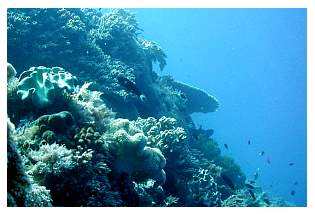 |
 |
|
Many soft corals grow in the extremely clear, nutrient-poor
waters on outer reefs. They gain a great deal of energy
from their symbionts due to the high water clarity,
but also feast on very fine particulate material washed
over the reef. Photos courtesy of Eric Borneman.
|
Many of the octocorals we keep are actually abundant in forereef,
reef flat and backreef environments. While it's true that
it is not unusual to find these species in deep water where
light and water flow can both be quite moderate (though water
flow is sometimes very strong even at those depths), they
are very common in much shallower water as well. It is not
unusual to see many commonly kept octocorals growing in mere
feet of water exposed to more intense light than we would
normally ever keep over our aquariums and more surge than
we can easily duplicate. In fact, it is not at all uncommon
to see these species growing intertidally such that they are
exposed to the air for hours at a time at least several times
per month. That soft corals as a group tolerate lower light
levels is not a mostly true rule with exceptions, it is a
rule that applies only to the exceptions! In fact,
contrary to popular belief, many octocorals are able to not
only withstand but actually benefit from brighter light than
many stony corals, including Acropora spp. (photosynthetic
saturation is often found to occur at higher irradiance levels
in some octocorals than most scleractinians). In terms of
water flow, these environments are often very well flushed
and experience some amount of wave action and surge. Indeed,
it is not at all uncommon to see thickets of Porites
and Acropora interspersed with large monotypic stands
of soft corals. Corals such as many Acropora spp. and
many soft corals often are thought by aquarists to be a world
apart in terms of their water flow requirements, yet they
are found right next to each other on the reef. There is no
reef environment where soft corals tend to be completely absent,
and this includes many upper reef slopes and reef crests.
What is apparent on most coral reefs is that stony corals
tend to be more abundant than soft corals, though this is
not universally true. For example, some reefs such as some
in the southern Red Sea can be spatially dominated by octocorals.
The reefs off of eastern Africa boast immense soft coral species
diversity and are dominated by them. On most reefs, though,
soft corals tend to grow as single colonies surrounded by
hermatypic stony corals or as patches (sometimes monospecific,
sometimes including several species). Soft corals also are
able to utilize environments that are somewhat marginal for
stony coral growth. More than anything it must be noted that
soft and stony corals can and do grow in the same environments
and that competition and perhaps the founder effect (whoever
got there first) are key ingredients (along with species specific
tolerances) in determining which species are present at specific
sites. Soft corals grow where they can outcompete stony corals
(and other organisms) for space.
Having said that, many soft corals do need very different
conditions from those provided on a reef flat. For example,
the gorgonian Diodogorgia nodulifera is typically found
in deeper water (below 30 m especially) where the light levels
are low and the water current is moderate. Many other such
soft corals, especially aposymbiotic species are found in
deep water. These species have proven categorically very difficult
or impossible to maintain in captivity, however, and should
therefore be avoided. Some soft coral genera such as Sarcophyton
or Sinularia may be very hardy and adaptable, while
others are quite the opposite. Still other species of aposymbiotic
soft corals such as Dendronephthya spp. are found in
habitats with their preferred water flow (strong and laminar)
regardless of light levels. The light might be very dim or
very bright, but the corals go where the food is and where
the water flow can deliver it (Fabricius et al., 1995).
These are also corals we cannot hope to properly husband with
the current state of aquarium technology (see Delbeek,
2002). Soft corals are often regarded as easy to keep,
yet many of the most beautiful octocorals are literally impossible
to maintain in captivity. Decisions about care also cannot
be made simply on a character such as growth form. The gorgonian
genus Gorgonia typically produces large fans that can
be several meters across. So does the genus Iciligorgia. While
Gorgonia is zooxanthellate, Iciligorgia is azooxanthellate.
While Gorgonia typically lives in shallow water, Iciligorgia
lives in deep water. While Gorgonia grows best in areas
of significant surge with clear waters, Iciligorgia
typically lives where water flow is more moderate and laminar
and the water is turbid. While the two look quite similar,
they are not, and these differences must be recognized if
success is to be had with either.
The degree to which soft corals use heterotrophy (feeding)
to satisfy their needs can vary radically between different
species. All of the aposymbiotic species get 100% of their
nutrition through feeding. Other species such as members of
the genus Xenia are more nearly autotrophic in obtaining
their energy. These octocorals tend not to capture prey and
instead increasingly use the photosynthesis of their symbionts
and dissolved organics to meet their needs. All other species
fall somewhere in between with some being more highly autotrophic
(such as Anthelia) while others are more highly heterotrophic
(such as Capnella or Nephthya). Variation is
the rule, with each genus and species being different from
the last. Given that there are hundreds of species of octocorals,
that is a lot of variation and it is totally inappropriate
to say that all soft corals have certain or particular feeding
requirements. It must be stressed, though, that most soft
corals are dependent upon heterotrophy for a significant
portion of their nutrition (including their energy demands),
especially at the moderate light levels they often receive
in captivity (Fabricius and Klumpp, 1995). Further, soft corals
can be very effective at utilizing POM, primarily when it
is very fine (Fabricius and Dommisse, 2000).
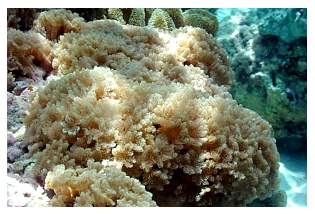 |
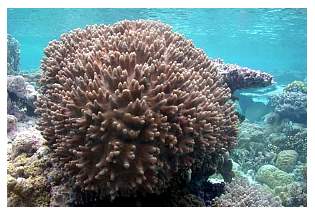 |
|
These commonly kept soft corals are growing in very
shallow water and therefore extremely bright light.
It would take powerful metal halides to replicate this
intense lighting. Left is a Clavularia
sp., right is a Lobophytum sp. Photos
courtesy of Eric Borneman.
|
Another concern when keeping soft corals is that they produce
secondary metabolites, often in copious amounts. Secondary
metabolites are usually low-weight molecules with complex
and often unique structures. Some of these chemicals are,
in effect, poisons. Soft corals in particular are known to
produce a large variety of extremely toxic secondary metabolites
(as are many other corals, though research until recent years
has focused primarily on octocorals and zoanthids). In a recent
search of the "Web of Science" using the keyword
"Sarcophyton" I found that perhaps 80% of
the hundreds of studies that arose discussed one or more of
the metabolites produced by this genus. This is an area of
a lot of research, mostly in the pharmacological field. While
many corals, such as most zoanthids, store these compounds
to decrease predation, some soft corals are known to actively
secrete these substances into the water column in order to
harm nearby corals, sponges and algae. Many people have assumed
correctly that these compounds can be harmful to stony corals.
What I find interesting, and sad perhaps, is that people have
seemed to carry this idea only to "SPS" corals.
People rarely keep soft corals (especially Sarcophyton,
Sinularia, Lobophytum and other highly toxic
genera) with so-called "SPS" corals, or are at least
aware of this risk, but they rarely, if ever, consider the
risks to other organisms. The toxins these soft corals produce
may not be targeted toward Acropora in particular;
rather, most of them are wide-ranging in their effects and
are potentially harmful to any sort of stony coral, other
soft corals, anemones, fish and even the aquarist! These effects
tend to vary highly depending on the tolerance of the poisoned
animal and many other conditions. The critical thing to understand
is that they are potentially toxic to anything in the aquarium,
but that some organisms are much more sensitive than others.
For this reason, the typical stocking protocol of most reef
tanks couldn't be more ill-advised, in my opinion. Normally,
reef aquarists stock tanks in order of the corals' perceived
hardiness. Usually, "leather corals" (alcyonians),
zoanthids and mushroom polyps are the first corals in the
tank. They are usually tolerant enough to survive the poor
conditions of a new tank, although even these corals often
show problems. After a few months of these corals struggling
along, the tank begins to mature and they start to do really
well and thrive. As they grow the aquarist becomes confident
that the tank is becoming healthy and starts to add "LPS"
corals. The resident soft corals sense the intruders (chemoreception
is acute in anthozoans) and begin to secrete more secondary
metabolites, trying to prevent their intrusion. Some stony
corals may tolerate being housed with these soft corals and
do well, while others may not tolerate them and die. These
become just a few of many mysterious deaths that the tank
is likely to sustain. As more time goes by and the resident
corals grow and fill more space, the aquarist becomes more
confident in his or her skills and begins to add all sorts
of "SPS" fragments, often placed very near other
corals including soft corals. Sure enough, the soft corals
sense the intruders again (all corals, including stony corals,
release chemical compounds into the water and corals use these
to identify their neighbors). All the resident corals then
begin an all-out assault on the newcomers, trying their best
to keep new corals from settling so that they can retain their
own space. Not only this, many of the corals are probably
fairly large by this point and can make large amounts of allelochemicals.
After a number of mysterious deaths the aquarist gets frustrated
and either declares that stony corals are too difficult to
keep or seeks help and perhaps starts using activated carbon
and water changes to control the concentrations of secondary
metabolites. Usually, some soft corals are removed at this
point. After a few years the tank is once again stable, many
stony corals are growing well, and there are fewer mysterious
deaths than before. To reach this point, however, required
the sacrifice of a number of corals that needn't have died.
Instead of stocking first with competitive soft corals (and
zoanthids and mushroom polyps) and then adding stony corals
that are likely to be killed by the resident corals, it would
be a much better idea to allow the tank to mature an extra
couple of months without corals, then add hardy, pioneer stony
corals to avoid these problems from the beginning. After a
year hundreds of dollars will have been saved; few, if any,
corals will have been lost; the resident stony corals will
be growing large and beautiful and the only sacrifice will
have been waiting a few more weeks to add corals. Impatience
kills, every time.
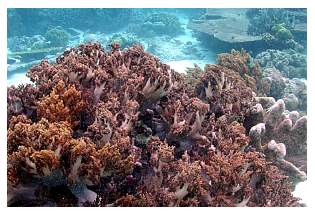 |
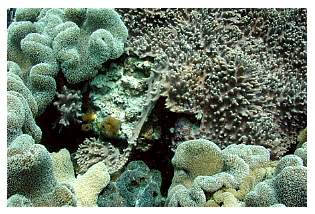 |
|
Left: Notice the Acropora and other stony
corals in the background while the Klyxum has
completely overtaken an area of reef. Right:
When they occur, soft corals often competetively exclude
stony corals. Photos courtesy of Eric Borneman.
|
LPS Corals (order Scleractinia)
The three groups discussed up to now are real taxonomic units
recognized by scientists (mushroom polyps comprise the order
Corallimorpharia, zoanthids the order Zoanthidae, and soft
corals the subclass Octocorallia). All species of stony corals
comprise the order Scleractinia. What, then, is the taxonomic
unit used to differentiate large-polyped from small-polyped
stony corals? I'm asked this question quite frequently, and
the answer is that there isn't one. The dividing line between
what constitutes a "large" versus a "small"
coral polyp is entirely arbitrary and based only on opinion.
I hear from some aquarists that Favia is a large-polyped
genus and from others that it is a small-polyped genus. I've
heard the same about Turbinaria reniformis. There
is no ecological or biological reason to divide stony corals
based on polyp size. In fact, there is no natural divide
at all-stony coral polyps can range from as little as 1 mm
to over 30 cm across and different species embody this entire
range of polyp sizes. The reality is that nearly every taxonomic
family of zooxanthellate stony coral (there are almost 20)
comprises species having very small polyps and very large
polyps. Similarities in appearance do not necessarily imply
similarities in relatedness (fortuitous for folks with balding,
fattening relatives). Polyp size alone simply does not reveal
the sort of care a stony coral should receive.
|
Top left: Compare the environment this Euphyllia
ancora is growing in to the Symphyllia below.
Both corals have large polyps, but they live in totally
different environments. Top right: A Pachyseris
sp. growing in the same reef as the E. ancora.
Again, polyp size does not determine environmental needs.
Bottom left: A large Symphyllia sp. growing
in very shallow water. Bottom right: A small
Symphyllia sp. growing just below the tidal line.
Photos courtesy of Eric Borneman.
|
Some species aquarists ascribe to this group seem to tolerate
elevated dissolved nutrient levels well, but this is extremely
variable. While some are extremely tolerant in this regard,
others can be much, much more finicky. This varies along species
lines as well as occasionally between individuals. I've seen
aquariums where corals such as Trachyphyllia geoffroyi
were able to maintain themselves and appear quite healthy
even as nitrate levels approached or exceeded 40 ppm. Some
other corals normally thought to belong to this group, such
as Euphyllia spp., seem far less tolerant in my experience.
For example, a particular Euphyllia paradivisa in a
friend's tank would begin to look quite badly whenever the
nitrate was allowed to reach or exceed 10 ppm. The tolerances
of the various species put in this group can differ radically.
Something that won't bother one will kill another and vice
versa. This isn't surprising as "LPS" is an artificial
and arbitrary grouping of totally unrelated species. Humans
(genetically, temporally and evolutionarily) are much closer
relatives of whales and armadillos than some of these corals
are to each other, and I am not exaggerating. Going back to
the previous section, some stony corals are particularly sensitive
to the presence of certain soft corals. Euphyllia (often
placed by aquarists into a tank with soft corals) is regularly
highly sensitive to them. In one particularly vivid example
of their intolerance for many soft corals, I witnessed the
effects of mixing a shipment of about 10 yellow Sarcophyton
sp. with a tank full of various Euphyllia spp. There
were perhaps 15 Euphyllia colonies, mostly E. paraancora,
split between two 50-gallon tanks. The Sarcophyton
were placed into each tank. Within three days all of the Euphyllia
spp. looked terrible and within five days four colonies had
been completely lost and many others were badly deteriorated.
When moved to a different system, however, each colony recovered
within a week. Merely a day after the move each colony had
expanded a great deal, whereas they had been completely retracted
before. Despite experiences such as this, aquarists insist
on housing these corals with aggressive soft corals without
forming a contingency plan in case the corals do not tolerate
each other. I'm not sure why, except perhaps that the idea
that larger-polyped stony and soft corals need the same conditions
is so ingrained. While Euphyllia and some other genera
seem very sensitive to being housed with soft corals, others
appear to be very tolerant. I've never seen corals such as
Mycedium be particularly affected by soft corals in
the aquariums I've observed, but this is not to say they never
could be. In fact, I bet soft corals somewhere on some reef
or in someone's tank have affected them. Again, the point
is that the variation is huge and grouping everything under
a particular heading will cause problems and mortalities.
In terms of their water flow and lighting requirements, corals
lumped into this group couldn't be more different. No species
with large, fleshy polyps is able to tolerate most pounding
wave action, but many are found in strong currents in nature,
stronger than what most people provide even in "high-flow"
aquariums. Corals such as many Lobophyllia, Favia
and other faviids, Turbinaria, certain Goniopora,
etc. all have large to very large polyps, yet are often found
in quite strong water flow in nature. These species are common
on reef flats and upper reef slopes where many of the light
and flow loving "SPS" corals grow. On the opposite
end of the spectrum, corals such as many Euphyllia,
Trachyphyllia, other Goniopora, etc. are often
found in deep or turbid water where light levels can be very
low and water currents are often gentle (see Borneman,
2002). Those two environments are as different as night
and day, yet aquarists say that all these corals belong to
the same group and require the same conditions due to similarities
in their external appearance. This simply is not so. The genus
Turbinaria is an interesting case, in particular. This
is a modestly-sized genus containing 11 species. Of these
11, two have large polyps, five have moderately-sized polyps
and four have rather small polyps. Are we to believe that
T. reniformis is more similar to Acropora, Montipora
or Stylophora than to T. peltata because its
polyps are closer to those in size? This is analogous to saying
that I am more closely- related to someone I meet on the street
who is my height than I am to my mother, who is shorter than
I. If a doctor asks for my family medical history, whose should
I give, my mother's or the stranger's? These species are found
in essentially the same environments, too. Often they are
found in shallow, brightly-lit areas with turbulence, though
they are sometimes found deeper. Polyp size has nothing to
do with which stony corals are related to which other stony
corals or with their tolerances or requirements.
In terms of feeding, it has been suggested, both in aquarium
literature and within the scientific community (Porter, 1976),
that larger-polyped corals eat more than smaller-polyped corals.
This hypothesis has subsequently been tested and has been
shown to be completely baseless. Some corals eat a lot and
some corals don't eat nearly as much, but polyp size rarely,
if ever, has any correlation to this. If anything, larger-polyped
corals are often found to eat less, not more, than smaller-polyped
corals (e.g., Coles 1969; Sebens et al., 1996). What
people generally have found is that some larger-polyped corals
often cannot use light instead of food for as large a portion
of their energy needs as others can. Some corals can get as
much as 90% or more of the energy they need (not nitrogen
or other nutrients, though, just energy) strictly from light
(Bythell, 1988), whereas many larger-polyped corals are typically
limited to less than 90%. In effect, all this means is that
some larger-polyped corals are not as adaptable as others
to differing amounts of food or light. If lots of light but
no food is available, some corals with larger polyps cannot
get enough energy and begin to starve in a short time. If
lots of light but no food is available, some smaller-polyped
corals can use the light more effectively and can stave off
starvation for a little longer. Again, this is all speaking
very generally, because each species and each genus is very
different from the rest.
|
Though the tentacle development on these larger-polyped
corals (middle & right) looks more
impressive than the smaller-polyped coral to most people,
plankters may have more to fear from the Seriatopora
(left). Photos by Chris Jury.
|
SPS Corals (order Scleractinia)
I love the aquarists who consider themselves SPS aficionados
(some of my best reefer-buddies are "SPS junkies"),
but I really loathe this term. It is often used, yet it means
absolutely nothing about a coral except that it can't eat
really large pieces of food. Whoopee! The problem is that,
as with each of the groups discussed here, aquarists think
that this designation prescribes some particular sort of care
or conditions, and this is nonsense. Most corals on a reef
are stony corals and most of them have small polyps. Looking
at various photos of a reef, "small-polyped stony"
becomes nearly synonymous with "coral." The corals
on a reef are almost all small-polyped stony corals. Some
small-polyped corals are on the reef crest getting pounded
by waves and light, and other small-polyped corals are growing
two feet into a cave getting no direct light and little water
movement. There are small-polyped corals that grow hundreds
of feet down and have special mechanisms to capture the nearly
invisible light. There are small-polyped corals that grow
in fields of seaweed. There are small-polyped corals that
live in places where the temperature fluctuates by 15°
Fahrenheit in less than 10 minutes or varies from the 60's
in winter to the low 90's in summer. There are small-polyped
corals that survive, grow and don't bleach in temperatures
that approach 100° F. in the summertime. There are small-polyped
corals that live on mud flats in water so murky the visibility
is not more than a few feet. There are small-polyped corals
that are nothing like what people think they are supposed
to be, and I tend to believe the corals are more right than
we are.
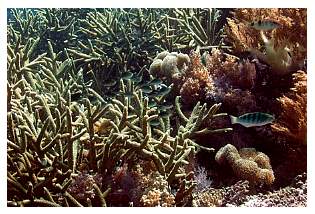 |
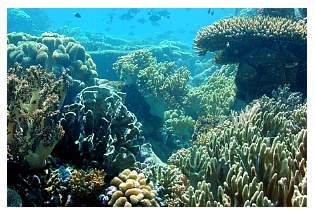 |
|
Many soft and stony corals, including Acropora
spp., grow near each other on reefs and in the same
environmental conditions. Replicating this in the reef
aquarium can be difficult due to the ability of many
corals to compete aggressively. Don't try this at home
(or at least keep a watchful eye)! Photos courtesy of
Eric Borneman.
|
The first myth (which is really a half-truth) is that corals
with small polyps strictly need very clean, nutrient-poor
water. The reason this is a myth is that it assumes these
corals are somehow different from any others. No coral needs
or benefits from being kept in water with high amounts of
nitrate or phosphate. Some tolerate it better than others,
but no coral needs it. Some genera are particularly sensitive
to these poor conditions, while others are more tolerant.
Other sorts of stress elicit other responses. I've seen a
Siderastrea that was overturned in a tank without light
and literally partially buried in sand for a month perk up
and start looking good again after only a week when turned
back over. How many corals can do that? No matter what the
stress is, some take it well and some take it poorly. "Small-polyped
stony" describes a huge group of corals comprising hundreds
of species and well over a dozen families, some of which have
had independent evolutionary tracks for hundreds of millions
of years. The genus Acropora alone comprises nearly
350 species, some of which grow in clear oceanic water on
the tops of reef crests while others grow in muddy lagoons
with dim light, slow water flow and a constant rain of semi-organic
particles. It is easy to see why corals with small polyps
vary so much in their stress tolerances.
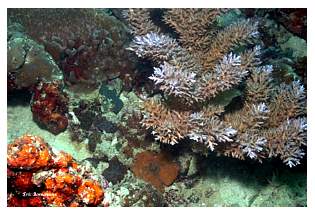 |
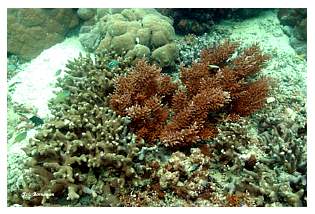 |
|
Many Acropora spp. are adapated to live in lagoons.
This environment is very different than what is often
recommended for them. Photos courtesy of Eric Borneman.
|
As far as these corals' "strong light and water flow"
requirements, this section's first paragraph should give us
some idea of why no single recipe for success is enough. Some
species are wide-ranging and can be found in many types of
habitat-literally from upper reef slopes, to intertidal reef
flats, to seagrass beds, to mud flats. Other species are more
restricted and grow only in one particular habitat. For instance,
Pocillopora molokensis is endemic to the Hawaiian Islands
and is found only in deep water. Acropora hyacinthus
is normally found in shallow water, but only where there are
strong currents and flushing. The water flow can't be too
strong, though, or its tabular growth form will allow it to
be ripped off the reef. This species often grows on reef crests
if they are not too turbulent or overly prone to storm damage.
In the most wave-swept areas or those prone to storms, digitate
Acropora and encrusting corals tend to be the only
species that can cope with the harsh conditions. Other species
of Acropora, such as many of the staghorn or bushy
species, cannot grow here as the wave action or storms would
too frequently break them apart (though there is a happy medium
with some amount of breakage and fragmentation allowing for
increased asexual recruitment and hastening spatial dominance
of many species) (Highsmith, 1982; Riegl, 2001). In fact,
most of the species that hobbyists often assume live on reef
crests do not, in fact live there, including most Acropora,
Montipora, Porites, etc. It is odd that aquarists
often think their aquariums replicate a reef crest. I've never
seen an aquarium that had sufficient water flow to shatter
staghorn Acropora colonies, but perhaps there's someone
out there who has the turbine from a jet engine attached to
their tank. Polyp size simply has nothing to do with either
light or water flow requirements. In fact, some smaller-polyped
corals are among the most tolerant of variable light and current.
Stylophora pistillata can grow in inches of water on
the reef crest or over 30 m deep in almost no current, but
this doesn't match the present view of what this coral is
supposed to be. Again, I tend to trust the coral more than
popular opinion.
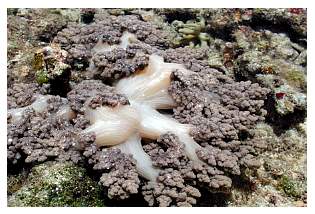 |
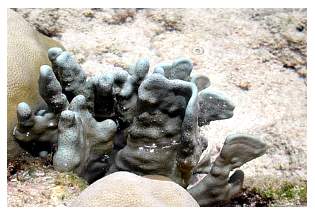 |
|
Left: Klyxum sp. growing intertidally.
Right: Heliopora coerulea, a very unique
octocoral growing intertidally.
Photos courtesy of Eric Borneman.
|
As far as food goes, corals with small polyps eat, and there
is no question about that. To reach the conclusion that feeding
these corals is not important requires a reversion to the
time before C.M. Yonge's studies in the 1930's on the Great
Barrier Reef (or earlier), as well as complete ignorance of
the past 75 years' worth of research. While it is true that
some of these corals eat more than others, the species that
are least reliant on food are not those that hobbyists believe
are. In particular, study after study after study has found
that corals such as Acropora are highly efficient predators,
and that they eat large amounts of prey including a lot of
zooplankton and particulate material every night in nature
(Anthony, 1999; Anthony, 2000; Bongiorni et al., 2003;
Bythell, 1988). Corals such as Porites cylindrica tend
not to eat quite as much food as most corals, but they are
the exception and not the rule (Anthony and Fabricius, 2000).
They have merely circumvented the need for large amounts of
food and can subsist on very little. Just to put some numbers
on things, as aquarists tend to resist tooth and nail the
idea that these corals eat things and need to be fed, Bythell
(1988) found that Acropora palmata (the ultimate "SPS"
coral) gets 70% of the nitrogen it needs for health, growth
and reproduction from eating things such as zooplankton and
particulates. These corals have to eat to be healthy! A recent
study by Ferrier-Pages, et al. (2003) that was later
confirmed by further testing found that corals that are fed
grow their skeleton 30-75% faster, grow tissue 2-8 times faster,
have more protein, have more chlorophyll and are in every
way healthier and doing the things we want them to do faster
than those that are not fed. Conversely, corals that are not
fed suffer a precipitous drop in the amount of protein in
their tissue and in their chlorophyll a concentration (Shick
et al., 2005). A study by Sebens, et al. (1996)
examined the differences in prey capture between two corals
(Montastraea cavernosa and Madracis mirabilis).
The Montastraea (relatively larger polyps) is known
to catch a lot of food and to be very heterotrophic. The surprise
is that the same sized colony of the Madracis (relatively
smaller polyps) in a flume caught and ate 36 times as much
food in the same span of time! Hmmm, seems to me like they
need to be fed. Please do not take this information to mean
that corals with small polyps need more food than corals with
large polyps (let's not overcompensate now!), or you'll be
missing the whole point. My intention is to illustrate that
different species of corals show different food preferences,
and that these preferences are not based on polyp size
but rather on differences in each species' niches. It must
also be noted, however, that a single species of coral can
and will adapt to higher rates of heterotrophy or autotrophy
depending on the conditions in which it grows (Anthony, 2000;
Anthony and Fabricius, 2000). Corals often thought of as requiring
bright light and little food can, and do, adapt in nature
to conditions of low light with high food availability all
the time.
The last major myth surrounding the term "SPS"
is that these corals are all supposed to be very colorful
and that if they are brown, something is wrong. This is nonsense.
Many of these corals in nature are brown. Of course, it depends
on the environment examined, and some places do contain primarily
colorful corals, but not all places. Many locales have predominately
brown and gray corals with the rare colorful one mixed in.
These corals are perfectly healthy, their environment is just
fine, and nothing at all is wrong with the situation. As many
have discussed before, predicting coral coloration is often
an exercise in futility. First, not all corals have the genetic
machinery to be colorful, just as not all people have the
genetic machinery to have blue eyes or red hair or grow to
be seven feet tall. Beyond this, complex environmental and
physical factors interact in ways that are still not understood
to make corals either produce or not produce colorful pigments.
Light is certainly a critical factor for the production of
at least some coral pigments (Dove et al., 1995; Dove
et al., 2001; Salih et al., 2000), while others
do not seem to be induced by light intensity at all (Mazel
et al., 2003). Both an additive (like internal reflectors)
and a subtractive (like Venetian blinds) role has been assigned
to certain coral pigments (Dove et al., 1995; Dove
et al., 2001; Kawaguti, 1969; Salih et al.,
2000; Schlicter et al., 1986). Mazel et al.
(2003) argue that these pigments likely do not have a photoprotective
role as has been suggested recently by Dove et al.
(2001) and Salih et al. (2000). Personally, I find
that the case has been well made that at least some coral
pigments (certain GFP-like proteins-the "pocilloporins"
of old) likely are playing a photoprotective role in certain
corals (particularly in pocilloporids and acroporids) but
also that certain other pigments (exemplified by GFP, green
fluorescing protein) are not involved in this process. I think
that, to an extent, each set of authors may have slightly
overstated their positions. This leaves all the other coral
pigments (and there are many) with unknown functions or cues
inducing their production. Especially interesting are the
pigments produced by azooxanthellate hard and soft corals.
What purpose or function might these pigments have? While
hypotheses have been offered, no consensus has been reached.
The functions and the factors that induce the production of
these and many other pigments in zooxanthellate corals are
currently unknown, but in many cases light probably is not
a factor (at least not directly).
Speaking of coloration, elevated concentrations of nitrogen
(ammonium and/or nitrate) are often blamed when corals (especially
Acropora but others as well) "brown-out."
This happens through increases in the density of zooxanthellae
in coral tissue and increases in the chlorophyll content of
those zooxanthellae (making each one darker) (Hoegh-Guldberg,
1994; Marubini and Davies, 1996). To my knowledge, phosphorus
(phosphate) has never been implicated in this process, though
it has been shown to decrease calcification and linear extension
when elevated (Ferrier-Pages et al., 2000). This makes
sense because most algae (including zooxanthellae) are good
phosphorus competitors and their growth rate or ability to
overpopulate a coral is probably not limited by phosphorus
in most cases. Many cyanobacteria, by comparison, are poor
phosphorus competitors and good nitrogen competitors due to
their ability to fix atmospheric nitrogen (Iizumi and Yamamuro,
2000; Kayanne et al., 2005). Zooxanthellae in hospite
(living inside the coral), assuming their growth rate is limited
by the availability of some essential nutrient, are more likely
nitrogen limited than phosphorus limited, especially in tropical,
neritic waters (see Klausmeier et al., 2004). The increased
growth rate of most kinds of algae when nitrogen is abundant
and phosphorus is limiting, plus the increased growth rate
of cyanobacteria (N-fixers) when phosphorus is abundant and
nitrogen is limiting (notice the two offset each other), creates
the classic Redfield ratio observed in the ocean. For those
unfamiliar, there is a highly perceptible trend for the ratio
of available atoms of nitrogen and phosphorus in oceanic water
(and often freshwater as well) to be 16:1, the same as the
average ratio of those elements found in phytoplankton (Redfield,
1958). That brings up the topics of nutrient
stoichiometry, resource competition, zero-net-growth isoclines
(ZNGIs) and all sorts of other interesting interactions (nutrient
stoichiometry and ZNGIs-Dr. Litchman would be so proud!),
but those are for another discussion. The important things
to understand are these: under normal circumstances phosphate
probably cannot cause a coral to "brown-out" by
stimulating the growth of its zooxanthellae (though it does
have other negative effects and its concentration should be
kept very low in the aquarium), and nitrogen (ammonium and/or
nitrate) probably can cause this reaction in some cases.
A logical question is, does nutrient enrichment (such as
that caused by human activities) always have a negative effect
on corals and on reefs? The most ambitious project to try
to answer this question was ENCORE (Elevated Nutrient on Coral
Reefs Experiment) administered in the lagoon off One Tree
Island in the Great Barrier Reef. Nutrient enrichment was
simulated at each low tide by adding ammonium and phosphate
to twelve microatolls. This nutrient-rich water was replaced
with low-nutrient water from the ocean with every high tide.
During the first year of the experiment ammonium was increased
to a concentration of 10 mM (about
0.17 ppm-equivalent to about 0.6 ppm nitrate). The expected
results (increased algal growth and biomass, decreased coral
growth rates and reproductive effort, etc.) did not occur
in most of the treatments. The next year the ammonium concentration
was doubled to 20 mM (0.35 ppm-equivalently
1.2 ppm nitrate) (Koop et al., 2001). Some of the microatolls
did show poorer coral health, but as Szmant (2002) has pointed
out, this may be due to factors unrelated to nutrient enrichment.
At 20 mM, this experiment also
utilized nitrogen concentrations an order of magnitude higher
than what is normally reported for even polluted coral reefs
(Szmant, 2002). More moderate evidence comes from Marubini
and Atkinson (1999). They enriched seawater with 5 mM
nitrate (about 0.3 ppm) and saw no effects on growth rate
in Porites compressa. They also tested the effects
of lowered pH, which did decrease growth significantly (something
for aquarists to keep in mind). Atkinson et al. (1995)
also reported high sustained coral growth rates (and good
health) in the corals maintained at the Waikiki Aquarium despite
elevated nutrient levels: 5 mM
nitrate, 2 mM ammonium, and 0.6
mM phosphate (about 0.3, 0.035,
and 0.06 ppm, respectively). In this system pH was slightly
low and alkalinity slightly elevated. Along these lines, while
Marubini and Davies (1996) found that as little as 1 mM
nitrate (0.06 ppm) could reduce the rate of coral growth,
the effects of 20 mM nitrate (1.2
ppm) or ammonium (0.35 ppm) were eliminated by the addition
of 2mM bicarbonate (Marubini and Thake, 1999). In other words,
if the alkalinity was kept a bit higher than normal, the effects
of nutrient enrichment, at least on growth, were undone. This
lends support to the hypothesis that nitrogen enrichment decreases
coral growth not because these levels of nitrate and/or ammonium
are inherently harmful to the coral, but rather because at
higher nutrient levels the two ongoing processes of calcification
and photosynthesis compete for the same limiting resource:
dissolved inorganic carbon, DIC. If seawater's alkalinity
is raised slightly (by the addition of carbonate or bicarbonate),
then carbon no longer limits either photosynthesis or calcification,
nor is growth limited by this factor, either. To all the aquarists
who think they get higher rates of coral growth with slightly
elevated alkalinity: it looks like you're right! Do realize,
however, that while these nutrient concentrations are elevated
compared to most natural reefs, they are also at about the
lower-level of detection for most hobbyist grade test kits.
Based on this evidence it is my opinion that reef tanks are
best maintained at or below these levels: 3 mM
nitrate (about 0.2 ppm) and 0.3 mM
phosphate (about 0.03 ppm). This is in comparison to less
than 0.6 mM nitrate (about 0.03
ppm) and less than 0.2 mM phosphate
(about 0.02 ppm) on most coral reefs (Kleypas et al.,
1999).
Since reasonable quality test kits exist within the hobby
and can detect even these relatively low nutrient levels,
I find it curious that folks sometimes complain of "nutrient
issues" as the reason their corals are not attaining
some particular coloration, even when there are no signs of
problem algae and nitrate and phosphate are both undetectable.
Zooxanthellae, like any algae, can use inorganic sources of
nitrogen only directly. If nitrate and ammonium are low in
concentration, no other test, prayer or voodoo is required
to affect the zooxanthellae, at least in terms of their ability
to mask coral coloration. Nutrients are not hiding somewhere
and somehow influencing the zooxanthellae. This simply is
not possible. What is possible and is certainly the
cause of browning are the many unknowns yet to be resolved
in the understanding of coral coloration. The bottom line:
brown is neither bad nor unnatural. Light and low dissolved,
inorganic nitrogen sources affect this directly, but so do
many other, unidentified factors.
For all these reasons, I find the term "SPS" to
be utterly useless, often misapplied and to really hold back
progress in both husbandry and care of many corals.
The Solution
To summarize, what we are currently
doing is lumping all species of corals into five groups based
primarily on their gross physical appearance. Certain characteristics
have been assigned to each group describing what is supposedly
its appropriate care. While mushroom polyps, zoanthids and
soft corals do each represent valid taxa, the variation from
family-to-family, genus-to-genus, species-to-species and even
individual-to-individual is profound. Different colonies in
each of these groups often grow in radically different environments
with radically different environmental parameters compared
to others in that same group, and they cannot be expected
to do well (except due to most corals' innate ability to adapt)
in a single, prescribed set of conditions. The scenario for
large-polyped stony and small-polyped stony corals is even
worse. All species of stony corals comprise the order Scleractinia.
There is no reason to split this order into two groups with
polyp size as the dividing characteristic. Polyp size in scleractinians
does not determine light preferences, food preferences, water
flow preferences, or any preferences whatsoever, nor does
it even imply relatedness. The size of a coral's polyps actually
has very little, if anything, to do with that coral's natural
history and requirements. There is no natural divide in the
continuum of polyp sizes. There is a smooth transition in
polyp size from very small to very large in stony corals.
Any dividing line is totally arbitrary.
|
These corals were all grown under power compact fluorescents.
Polyp size doesn't necesarily say anything about a coral's
lighting needs. Photos courtesy of Kirby Adams.
|
What is the result of adopting these faulty coral keeping
recipes? In the best-case scenario the environmental parameters
are actually a good analog of what that coral needs to be
healthy, and it grows and lives fine. In a more moderate scenario
the environmental parameters provided are not analogous to
those in the coral's natural environment, but it manages to
adapt and survive in the odd conditions (though it will never
thrive the way it could in nature). Sadly, it is prone to
major problems at the slightest hint of stress. In the worst-case
and all too common scenario the coral simply fails to adapt
to the inappropriate conditions into which it has been placed,
and it dies. It has been estimated that Indonesia alone exports
some nine million pieces of live coral per year, almost all
of them headed to the U.S. I guarantee that at the end of
a year there are not nine million new, live corals in this
country. This is considering only Indonesia, not to mention
all the other coral exporting countries. Sadly, a lot of corals
die in captivity.
That, really, is the point of all this discussion: reducing
coral mortality and increasing the hobbyists' rates of success
(though these principles apply to any sort of organisms).
After all, we all want to be successful hobbyists. No one
enjoys or wants to cause coral mortality, both from an economic
and altruistic view. I think we all can do something to effect
positive change for ourselves as well as for others.
I always hate it when I hear someone speak about some issue
or problem and then, at the end of the talk, he or she doesn't
offer an adequate or implementable plan for how to fix that
problem. I refuse to be "that guy," so here we go…
I propose that corals henceforth be described by genus (or
best guess of the genus) and growth form (tabular, plating,
digitate, etc.), where applicable, in any discussion about
them whatsoever, but especially when related to their proper
care. What really needs to be done is to shift the terminology
because, by something as simple as referring to a coral in
this way, we will dramatically reform the way corals are treated
in captivity.
Let me use an example to illustrate what I mean.
Someone might come into the store where I work because he
or she is having trouble with slow recession in the corals
in their tank.
"What kinds of corals are having the problem?"
I would ask.
"SPS-it's weird, my plate coral is fine," they
respond.
Guessing that they are referring to a Fungia as
the plate coral I inquire, "Do you know what genus
they're from?"
"Acropora, they're all Acropora."
"Ok, how old is your tank and what kind of light and
water flow do you have?"
"Oh, I've got 130-watts of power compacts-they're
real bright-and two Maxijet 600s on a wavemaker, so it's
good flow. The tank's a 20-gallon, about six months old."
"Ok, I think I know what's going on. Those corals
are a bit demanding. Usually, you want metal halides for
them to do best. The power compacts, while they look bright,
aren't bright compared to the sun. Also, a little bit stronger
water flow would be good for those corals. It wouldn't hurt
to triple or quadruple that water flow for them. What would
probably do best in there right now are other kinds of stony
corals such as Trachyphyllia-open brain-or Euphyllia-frogspawn
and hammer coral."
They would go home knowing what sorts of corals in particular
would do well in their tank, which ones wouldn't, and why.
If a particular genus is described as needing bright light
or strong water flow, and some parameters are actually put
on those subjective terms, people can enjoy a great deal more
success. Instead of lumping hundreds of unrelated corals together,
people would be more likely to succeed if each genus were
referred to by name and if species (based on growth form)
were treated differently in those genera that show large differences
between species (e.g., Acropora, Montipora).
These terms also hold back success and progress for some
other folks.
A reef hobbyist might be browsing in the store, saying he
or she doesn't really like his or her tank because it doesn't
look like a reef.
"What kind of lighting do you have and what do you
have for water flow?" is always my first question.
"I've got six VHOs, a big return pump and a Tunze
6000 on a controller-that's on a 90- gallon tank."
"Hmmm, have you looked at these branching Montipora
digitata?"
"I thought I had to have metal halides for SPS."
"Well, I usually prefer not to use that term myself
just because so many different kinds of corals have small
polyps. Some do best under metal halides; others such as
these Montipora would do great under VHO lighting,
and you have good water flow. They should do well for you."
The next time I talk to this person they tell me how their
Montipora is doing great and they pick up another
fragment, this time a plating colony. They're excited that
now their tank is starting to look like a reef. By using
terms like "SPS," aquarists with tanks which are
very well suited to inshore species, such as some in the
genus Montipora, often do not attempt to house them,
and instead often place these corals in a lot of light or
water flow compared to where they usually grow in nature.
When people ask me a question and use the term SPS, LPS,
softy, etc., I always ask if they know more specifically what
kind of coral they are talking about. If they don't, I answer
their question as thoroughly as I can, but also explain to
them why I can't answer the question very well without knowing
what kind of coral we're talking about. Then they understand
why it is so important to know at least the basics of coral
identification. The above terms just aren't good enough to
tell us much of anything about a coral. When I refer to a
coral I always use the name of its genus (and species, if
known, e.g., Euphyllia paradivisa). I try to include
a common name when talking with new hobbyists, so they aren't
shell-shocked, but I use the scientific name as well.
If someone is interested in soft corals, I explain why some
species are very easy to care for while others (primarily
azooxanthellate species) are very, very difficult. While I
use the genus name, it is often a best guess (e.g., "Well,
it's probably Capnella or Litophyton-but it
could be something else, too."). It's lucky for us that
most soft corals are so adaptable.
I do the same thing when referring to stony corals and include
differences in growth form where applicable. If someone wants
to keep a bright pink Seriatopora in a tank with very
strong water flow, I make sure they understand that this coral
(with its fragile branches) usually grows in somewhat calm
areas. If someone wants to keep Acropora colonies,
I make sure they understand that digitate colonies need very
powerful water flow, whereas thinner branched colonies do
not. Imagine all the information (information critical to
success with these corals) that would be omitted if I referred
to corals just as SPS, LPS, soft, mushroom polyps and zoanthids.
The solution to this problem is simple and is something that
most advanced hobbyists already do most of the time anyway.
The terms mushroom polyp, zoanthid and soft coral are all
valid, but we should not think and should not give the impression
that these terms provide any information about the proper
care of these corals. They do not. The terms SPS and LPS are
not valid terms, and it would be best for everybody if they
just dropped out of reefkeepers' vocabularies. Just don't
use these terms at all. I don't, except when other people
bring them up. In that case I ask what kind of coral they
mean because those terms don't tell me anything, and I let
them know that (nicely). Eventually, they just stop using
those terms with me and refer to corals by name, and I would
bet that they do the same with most other people. Let us all
simply refer to corals by using their scientific names-that
is, their genus, or as close a guess as we have-and growth
form for very diverse genera such as Acropora and Montipora.
Let us also completely stop using the terms SPS and LPS, and
use the terms mushroom polyp, zoanthid and soft coral only
for basic identification, not for describing care.
There are a lot of people in this hobby. Most folks are new,
or nearly new, and get perhaps a year or two of experience
under their belts before dropping out due to the perceived
difficulty. I can't help but think we all do these hobbyists,
as well as ourselves, a huge disservice by using coral keeping
recipes that are obviously outdated. The knowledge about these
animals is available, but it must be seized, nurtured and
spread. By continuing to use these terms and acting as though
they give any true meaning to the discussion, we cling to
and spread ignorance. Isn't it about time that we all take
the tools and knowledge that we have and use them to move
forward? Isn't it time to scrap a faulty system that gives
poor results as often as good ones? I think so, and I know
that we all would be better off for it.
|

